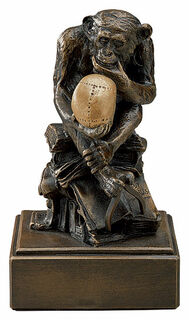Sculpture "Monkey with Skull" (1892-93), bonded bronze version
Sculpture "Monkey with Skull" (1892-93), bonded bronze version
Quick info
bonded bronze | size 8 x 13.5 x 8 cm (w/h/d) | weight approx. 0.7 kg
Detailed description
Sculpture "Monkey with Skull" (1892-93), bonded bronze version
The philosopher and sculptor Wolfgang Hugo Rheinhold (1853-1900) cast the debate about Charles Darwin's work in an almost iconographic form with his sculpture "Monkey with Skull". His contemporaries already attested that his diverse allusions were a "cabinet piece of superior humour" - after all, not only Shakespeare's "To be or not to be", but also Rodin's "Thinker" and circulating Darwin caricatures shine through.
However, Rheinhold's monkey is far more than humour in cast bronze from our ancestor's time. After all, the monkey wielding a tool for measuring skulls is not only sitting on Darwin's groundbreaking work but also the Bible. And on closer inspection, the "Inscriptio", the inscription, turns out to be the key to the allegory: "Eritis sicut deus", which translates to "You will be like God". With these words, the devil lures Adam and Eve to the tree of knowledge, which, as we know, leads to their expulsion from paradise. Thus, in the end, the sculptor Rheinhold proves himself to be a philosopher again: The "Monkey with a Skull" tells us that those who seek knowledge have to reckon with consequences. This is one of, if not "the" basic experiences of the 20th century, from the atomic bomb to genetic engineering.
Polymer cast with bronzed surface. Size 8 x 13,5 x 8 cm (w/h/d). Weight approx. 0.7 kg.
Customer reviews
Die erste Skulptur war defekt. Nach telefonischer Mitteilung erfolgte nach wenigen Tagen eine 2. Lieferung. Die Skulptur war deutlich geschützter verpackt und unversehrt. Die Dame am Telefon war ausgesprochen freundlich und zuvorkommend.
Danke
Sehr schöne Skulptur (steht direkt neben dem iMac), prompt geliefert.
alles Super!
Das Original ist noch schöner ausgefallen als die Abbildung. Es war eine gelungene Geburtstagsüberraschung für meinen Mann, der sich diese Skulptur schon lange gewünscht hat.
Vielen Dank.
About Wolfgang Hugo Rheinhold
1853-1900
They have their fates – not only the books but also the works of art and artists. The fate of the "Ape with Skull" and its creator Wolfgang Hugo Rheinhold couldn’t be more different. Immediately after Rheinhold presented the sculpture at the Great Berlin Art Exhibition in 1893 as his final project for his studies at the Berlin Royal Academy of Fine Arts, the Berlin sculpture foundry Gladenbeck & Sohn offered to produce licensed casts. These went not only to private collectors but also to many international scientific institutions. They can still be admired today: In the Royal College of Surgeons in London, in the Medico-Chirurgical Society in Aberdeen, in the Boston Medical Library and the Department of Zoology at the University of Edinburgh. The most famous location is probably a Russian specimen: It adorned (and still adorns) Vladimir Ilyich Lenin's desk.
While the fame and notoriety of the sculpture grew unceasingly, Rheinhold was almost forgotten after his early death. It was only following an exhibition in Aberdeen in 1989 that serious biographical research began. Most of what has been gathered about Rheinhold since then has only been published in the last 15 years.
Rheinhold was not only a sculptor but also studied philosophy. Moreover, he was a co-founder of a "German Society for Ethical Culture". Perhaps this explains the dazzling richness of meaning of his "Ape". It not only represents a thoroughly humorous commentary on the Darwinism debate but at the same time appeals to the ethical responsibility of all science with the Genesis quote "Eritis sicut deus" ("You will be as God").
Bronze powder is polymer-bonded. Special polishing and patination techniques give the surface of the casting an appearance similar to the bronze.
A plastic work of sculptural art made of wood, stone, ivory, bronze or other metals.
While sculptures from wood, ivory or stone are made directly from the block of material, in bronze casting a working model is prepared at first. Usually, it is made of clay or other easily mouldable materials.
The prime time of sculpture after the Greek and Roman antiquity was the Renaissance. Impressionism gave a new impulse to the sculptural arts. Contemporary artists such as Jorg Immendorf, Andora, and Markus Lupertz also enriched sculptures with outstanding works.












